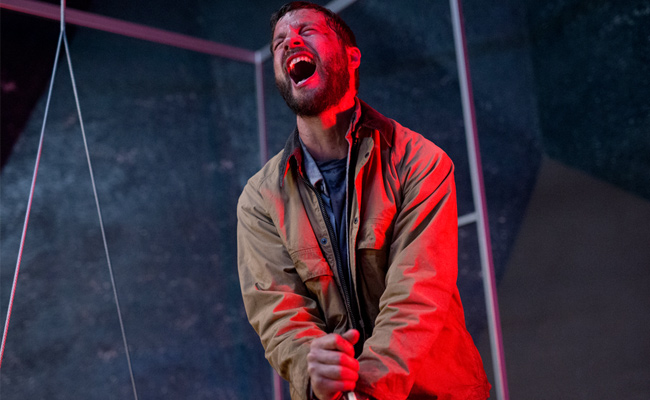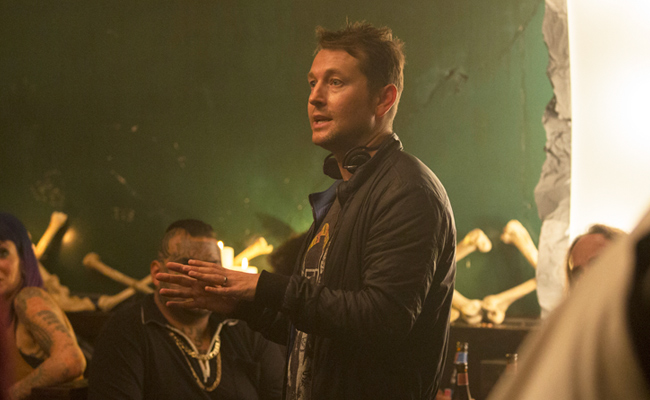
While I’ve seen and liked plenty of horror movies, I would never call myself a “horror fan.” That’s an intense and self-selecting group. Yet even as a non-horror fan, it’s hard not to notice that horror often feels like the only genre that still has artful compositions and classical suspense building. It’s a genre frequently (and usually fairly) maligned for a lack of creativity in terms of premises (I like to say that it’s always about a haunted house or a creepy little kid). But, or maybe partly because of that, horror filmmakers seem to take much more care, and pleasure, in the craft of execution.
And maybe that’s partly why horror is arguably the last genre in which independent films with low-budgets can still become breakout hits.
Leigh Whannell knows a little something about that. Film school buddies with James Wan in Australia at the Royal Melbourne Institute of Technology, Whannell collaborated with Wan, writing the original Saw short that Wan directed, for which Whannell says he spent $7,000 of his own money, which he’d earned working in television.
“What’s funny is that $7,000 was supposed to be the budget for the [full-length] movie,” Whannell told Uproxx. “The feature, the garage version. I spent all of it, and we shot this short on 16 millimeter. So you could say I ended up spending the entire budget of the film on this 11-minute short.”
Saw eventually became a feature, starring Danny Glover and Cary Elwes, which went on to spawn seven sequels. Clearly, Whannell’s $7,000 bet had paid off. Wan and Whannell went on to launch the Insidious franchise, which in turn metastasized into another four installments. That’s a solid track record for anyone, and you might expect Whannell to end up getting paid big bucks to write or direct the latest installment of an already-established franchise. But that doesn’t seem to be what drives him.
Instead, this month Whannell, a long-time screenwriter on Wan’s films and others, is back with Upgrade, his second feature as a director (after Insidious: Chapter 3). And it isn’t really a horror movie this time around.

Upgrade stars Logan Marshall-Green as a muscle car mechanic from the future, who becomes a quadriplegic following an accident, but has his movements restored by a sentient microchip that can control his motor functions (and you can probably imagine how that goes).
“In whatever small way I could, I wanted to give people a taste of the feeling that I had when I first saw The Matrix,” Whannell says. “The Matrix was a film that was very genre-driven. It seemed to be made up of different paths from different genre movies and there was a lot of influences in there. They invented this new fight style that became a trend, this bullet time. I loved that. That’s what I wanted to do, to sort of make a genre film that had its own style and its own thing.”
Upgrade does have that same quality, of inventing a new fighting style (which relates to the chip controlling the main character’s movements). But it’s striking that Whannell accomplished this not in a big budget action film like The Matrix (which reportedly cost $63 million), but in a scruffy, lower-budget genre movie from Blumhouse that cost a small fraction of that.
Upgrade probably isn’t cerebral enough that it will be on anyone’s radar come awards season, and the acting isn’t great, but for me it’s a throwback to the days when movies that didn’t scream “quality” or “prestige” could still be enjoyable. It reminded me of a working man’s Robocop, or some early Seagal movies — movies that may not have had brilliant dialogue (Robocop excepted, which clearly did have brilliant dialogue), but did have visual dynamism and a certain visceral thump. It made me realize how much I’d missed those kinds of movies. Those VHS classics that could be a little silly, in the way that genre movies are supposed to be a little silly, but not winky or weaponized stupid like a lot of genre fare now.
“As inspiration, I looked to sci-fi films that I grew up with. In the ’80s before the advent of CG, you had films like the Terminator and Scanners and Robocop that they were operating within a smaller box. If you go back and watch that original Terminator film, it’s scruffy, too,” Whannell says. “It’s really made on the smell of an oily rag and it’s kind of lean and mean.”
Being able to do interesting things with a smaller budget is certainly one lesson to be learned from horror filmmaking, which Whannell readily admits.
“I just don’t think bigger budgets serve horror,” Whannell says. “When someone gives you a huge budget, you have to do something with it. You have to justify the budget. Studios want to see entire cities being leveled. They want to see alien ships coming out of the sky, and that’s not something that lends itself to horror. I feel that what scares human beings mostly is quiet and private. Watching a city get washed away by a tidal wave isn’t necessarily getting at that primal human fear, but if I show you a film with just one person in a cabin somewhere in a remote area, all of a sudden, it’s frightening.”

But I also think it’s more than that. Horror is a genre where a lot of the stories are stock and the outcomes are somewhat predictable or predetermined, and everyone knows that going in. And so it becomes about finding moments, and using the cinematic language beyond communicating just what’s on the page to build anticipation, suspense. It’s about using mise en scene (and there’s really no unpretentious way to use “mise en cine” in a sentence) to generate emotion, to really revel in each moment. A lot of genres have lost that, trying to go as fast as they can to get to the next plot point. Which sounds like a recipe for a fast-paced, compelling movie, but often, paradoxically, just makes things more boring.
“I think that there is some subconscious rhythm of horror that’s embedded in me,” Whannell says. “With a horror movie, you’ve got to kind of keep your foot on the pedal. The tension should be increasing, and it’s kind of this metronome… And I think maybe I applied that to this film. Even if it’s not a horror film, per se, somehow that escalating sense of tension and surprise is coming out just because I’m so used to those rhythms.”
You really feel that in Upgrade, the way Whannell leads you, conditioning you to feel like a surprise could be coming at any moment. It’s a lesson horror could teach a lot of other genres, and it’s probably the reason so many directors who cut their teeth on tiny budget horror have gone onto handle major franchises — from James Wan directing the Aquaman movie to James Gunn going from Troma films to Guardians of the Galaxy.
Leigh Whannell isn’t directing a massive budget superhero franchise, at least not yet. Instead, he’s applying the lessons of horror filmmaking to where we may need it most: in original, non-franchise modestly budgeted genre film.






